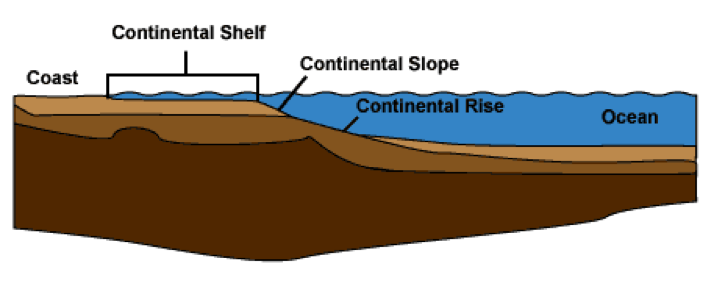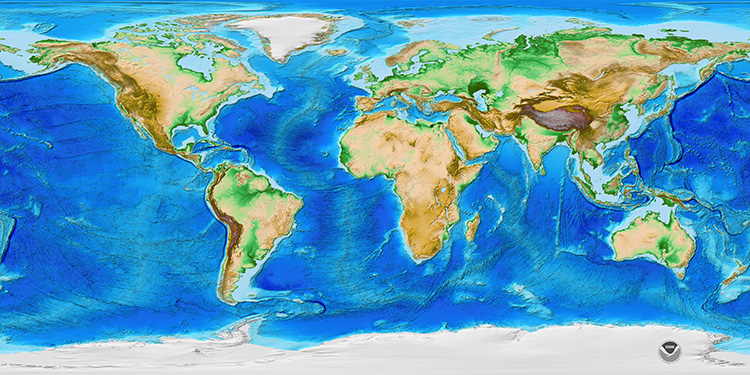Coastal Zones: The Margins of Continents
What are continental margins and what is the morphology of continental margins?
Continental Margins
Before we get too far along in a discussion of plate tectonics and coastal zones, we need to address the characteristics and form of continental margins because this is where the coastal zones that we will be referring to are located. As indicated by the name, continental margins are the edges of the continents and transition into the deep-water environments of the ocean basins. In general, continental margins have several distinct physiographic subenvironments, including the continental shelf, continental slope, and continental rise (see cross-sectional profile).
Continental Shelf
The continental shelf of a continental margin includes the seafloor that extends from the subaerial part of the continent, or shoreline, seaward to what is known as the shelf break. Continental shelves are typically relatively gently sloping surfaces, but a change in the gradient, or slope, of the continental shelf, takes place at what is referred to as the shelf break. There is a wide range of widths and gradients for continental shelves (see global map), but the global average water depth for where the shelf break is located is between 120 to 130 m. The global average width for continental shelves is approximately 75 km, and the average slope of the continental shelves is on the order of 6 to 8 degrees. One fundamental characteristic of continental shelves is that they can represent areas of extensive deposition because of their proximity to continental river systems that supply sediment to the continental margins. In fact, in some places, the continental shelf may be underlain by as much as 10 to 15 km of sediment, representing tens of millions of years of deposition above the granitic crust that forms the foundation of continental margins. On a global basis, the sediment at the surface of the continental shelves can derive from many different sources. Depending upon the location of the continental shelf and the characteristics of the adjacent continent, the sediment can be sourced from river systems, glaciers, and ice sheets, or can be calcium carbonate sediment sourced from organisms that produce shells of calcium carbonate.


Continental Slope
The continental shelves of the world transition into the continental slopes at the shelf break, where a distinct change in the gradient or slope of the seafloor exists. This change in gradient is coincident with a reduction in crustal thickness and a granitic to basaltic change in the composition of the underlying crust. Continental slopes are narrower than continental shelves, with a global average of only 20 km. They extend from the shelf break at approximately 120 m to as deep as 3,000 m with approximately a 4-degree gradient, but may be as high as 20 degrees. Overall, slopes also vary according to the nearby plate tectonic boundary, where slopes are steepest in locations adjacent to geologically young plate tectonic margins with narrow continental shelves. Deposition on continental slopes is predominantly finer-grained than the sediment that is deposited on continental shelves because there is less moving water from waves and tides to carry large sediment particles. One exception, however, is that during past periods of low sea level when rivers extended across continental shelves to meet the low sea level shoreline, relatively larger sedimentary particles were transported to continental slopes by river systems. As a result of the past low sea levels, some continental slopes contain buried deposits with large sedimentary particles such as coarse-sand and gravel. One unique feature about the outer parts of the continental shelves and continental slopes is that they may be the sites of submarine canyons through which sediment and water can be carried out to deeper parts of the ocean basin. Through the years, there has been much speculation as to how these canyons form, but most scientists agree that their origin is a result of erosion by oceanic currents, gravitational forces that cause failures and incision, or are the remnants of river valleys formed during past lowered sea level.
Continental Rise
The continental rises are the most distal parts of the continental margins and represent the transition from the slope to the deeper, flat physiographic regions of the open ocean basins known as abyssal plains. Wedges of sediment that can be several kilometers thick and several hundred kilometers wide developed because of the seaward transport of sediment from the more shallow water continental shelves and slopes. Overall, the gradients of the continental rises are typically less than 1 degree.
